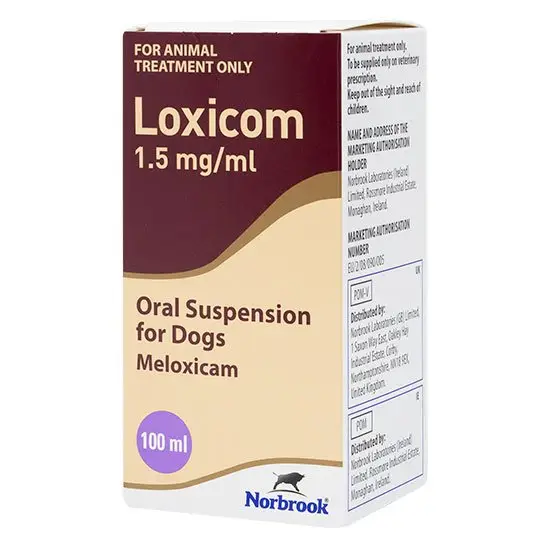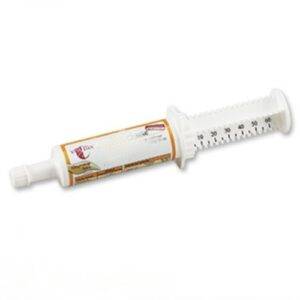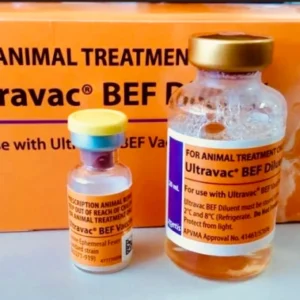loxicom 100ml
loxicom 100ml is a non-steroidal anti-inflammatory drug (NSAID) used to treat:
Pain
Inflammation
Fever
It works by selectively inhibiting the cyclooxygenase-2 (COX-2) enzyme more than COX-1, which helps reduce inflammation and pain while minimizing gastrointestinal side effects.
Indications (Uses)
Dogs:
Osteoarthritis and musculoskeletal pain
Post-operative pain (e.g., after soft tissue or orthopedic surgery)
Cats:
Post-operative pain (e.g., spaying, neutering)
Acute musculoskeletal disorders
Chronic kidney-related osteoarthritis (in some countries – off-label)
Horses:
Relief of inflammation and pain associated with musculoskeletal disorders and colic
Cattle and Pigs:
Respiratory disease
Diarrhea (calf scours)
Post-operative pain (e.g., dehorning, castration, surgery)
Mechanism of Action
Meloxicam blocks prostaglandin synthesis by inhibiting COX-2, which is primarily involved in inflammation, while sparing COX-1, which protects the gastrointestinal tract and kidneys.
This leads to:
Reduced inflammation
Decreased pain sensitivity
Lowered fever
loxicom 100ml Dosage and Administration
Dogs:
Oral suspension:
Initial: 0.2 mg/kg, then 0.1 mg/kg daily
Given with or after food
Injection:
0.2 mg/kg SC or IV once, followed by oral maintenance
Cats:
Injection:
0.3 mg/kg SC as a single dose
Oral suspension:
0.05 mg/kg once daily (use caution, especially long-term)
Horses:
Injection: 0.6 mg/kg IV once daily
Oral paste: 0.6 mg/kg PO daily (often up to 14 days)
Cattle:
Injection: 0.5 mg/kg IV or SC once
Pigs:
Injection: 0.4 mg/kg IM once
Always use species-specific formulations and dosing devices (syringes/spoons). Never use dog formulations in cats unless directed by a veterinarian.
Contraindications
Known hypersensitivity to meloxicam or other NSAIDs
Pre-existing gastric or intestinal ulcers
Kidney or liver disease
Dehydration, hypovolemia, or hypotension
Use in pregnant/lactating animals (unless approved by vet)
Do not use in animals under 6 weeks (dogs) or under 4 months (cats)
Side Effects
Common:
Vomiting
Diarrhea
Lethargy
Loss of appetite
Less Common but Serious:
GI ulcers or bleeding
Kidney toxicity
Liver enzyme elevation
Early discontinuation and supportive care are critical if adverse reactions occur.
Onset and Duration
Onset: Within 1–2 hours
Duration: 24 hours (once-daily dosing)
Withdrawal Periods (for food animals)
| Species | Route | Meat Withdrawal | Milk Withdrawal |
|---|---|---|---|
| Cattle | SC/IV | 15 days | 5 days |
| Pigs | IM | 5 days | — |
Always consult local regulations as withdrawal periods may vary by country or product variant. loxicom 100ml
Storage
Store at room temperature (typically below 25°C)
Do not freeze
Keep bottle tightly closed and use the measuring syringe provided
After opening:
Oral suspensions: Use within 6 months
Injectable: Use within 28 days
loxicom 100ml Summary Table
| Feature | Details |
|---|---|
| Drug Name | Loxicom (meloxicam) |
| Drug Class | NSAID (COX-2 preferential) |
| Formulations | Oral, injectable, paste, tablets |
| Species | Dogs, cats, horses, pigs, cattle |
| Main Uses | Pain, inflammation, fever |
| Common Side Effects | Vomiting, diarrhea, anorexia |
| Serious Risks | GI ulcers, renal failure, hepatotoxicity |
| Withdrawal (Cattle) | 15 days meat / 5 days milk |
| Prescription Only | Yes |
Clinical Insight
Well tolerated in most animals if used at appropriate dose and duration
Often used pre-emptively before surgery to control post-operative pain
Do not combine with steroids or other NSAIDs
In cats, long-term use is controversial and must be monitored closely loxicom 100ml





Reviews
There are no reviews yet.